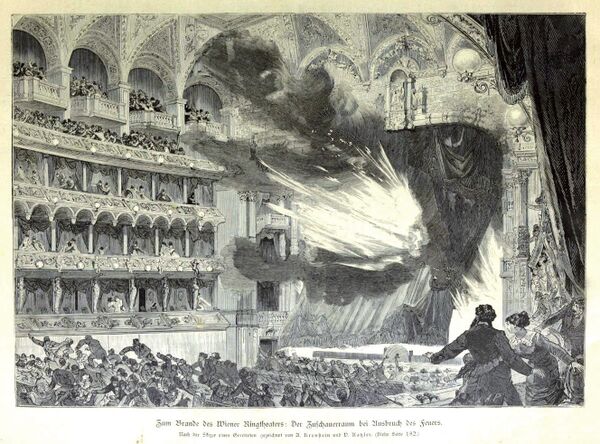Learning from Tragedy
In the age of candle, oil and gas lighting, theatre fires were frequent and often claimed many lives. The Ringtheater fire in 1881 was one of the biggest fire disasters of the 19th century, and it led to many developments in fire safety.
The fire at the Ringtheater took place on 8th December 1881, and according to official figures the death toll was 384; estimates put the number of dead at even higher, close to 1000. On that December evening, Jacques Offenbach’s Tales of Hoffmann was performed at the Ringtheater in Vienna, Austria-Hungary (Q696), which had opened 7 years earlier. As the audience took their seats for the 7pm start of the performance, the gas lights were ignited backstage.
Due to the failure of the electro-pneumatic ignition devices, gas flowed out and exploded the next time the ignition was attempted. The resulting fire jumped to the scenery rigging before rapidly spreading to the rest of the stage and eventually to the auditorium. An existing wire curtine, a precursor to the iron curtain, was not closed.
It was not until half an hour later that firefighters attempted to rescue the audience, hampered by fundamental problems. The emergency lighting, consisting of oil lamps, is said not to have been lit because – due to lack of money – the lamps were only filled for inspections. In addition, the emergency exits only opened inwards, which hampered fleeing visitors trying to leave the building. A draft of air coming in through a side window further fanned the fire. Due to a misjudgement of the situation, the police in the theatre anteroom discouraged helpers from further rescue attempts by saying ‘All saved!’.
In the following year, the so-called Ringtheater trial took place. All accused municipal officials were acquitted, while three theatre staff, the theatre director and two technicians, were sentenced to prison terms of between four and eight months and partial payment of damages. According to the court, they had failed to check each other and to install emergency oil lamps and had operated the wire curtine incorrectly. The director was released by imperial decree of clemency after only a few weeks in prison, but the stage technicians remained in jail.
The fire made an impact on preventive fire protection in Austria and internationally, especially in the theatre sector. The iron curtain was introduced to separate the stage from the auditorium, and scenery and props had to be impregnated with a fire-retardant treatment. The larger theatres were obliged to have uniformed security guards attend every performance, who had to make arrangements to direct the large crowds in the event of a fire. The guard had to remain in the theatre until the last spectator had left – a regulation that is still in force today.
After the fire, many theatres that were inadequate in terms of safety and lacked escape routes were closed. New buildings with innovative escape route concepts were built, and research was carried out into non-combustible decorative materials. In 1829, Vienna had put into place its first building code, comprising just 30 paragraphs. This was replaced by new building regulations in 1859 and 1868. The Building Code for Vienna of 1883, which took into account the Ringtheater fire and was a Lower Austrian provincial law, was valid until after the middle of the 20th century. It included, among other things, the requirement that doors in public buildings must always open outwards, which is still the case. In Germany, the Polizeiverordnung (police ordinance) for the operation of theatres came into being, which was replaced by the Versammlungsstaettenverordnung (assembly hall ordinance) that is in force today.
The fire also had an impact beyond safety regulations and procedures. The electrification of the theatres was also pushed forward, replacing gas lighting. The first public buildings with electric lighting were therefore theatres, which were not only better protected from fires, but accelerated the eventual development of stage lighting as a creative component of performance. The theatre reform movement of the early 20th century was thus able to move from two-dimensional images to three-dimensional space.
In wider society, as a spontaneous reaction to the fire, the Vienna Voluntary Rescue Society was founded. During the investigation of the fire, a method to identify the bodies based on the position of the teeth was practised for the first time, laying the foundation for the later renowned Vienna School of Criminology. It was the beginning of forensic dentistry.
The development of technical theatre throughout its history has been driven by new technologies, and people with new ideas about theatre. Sometimes, however, it takes the tragedy of a major disaster to force new and better ways of working.


